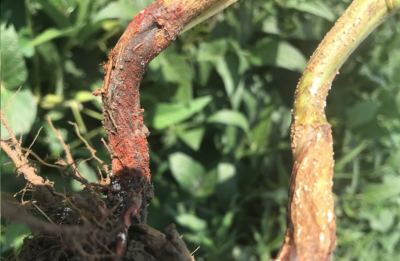 Red Crown Rot (GROWMARK, Inc.)
Red Crown Rot (GROWMARK, Inc.)
- Stem diseases in soybean start to show up in fields around R3.
- Many stem diseases share similar symptoms.
- Knowing what to look for can help with disease identification in the field.
Symptoms and signs of soybean stem diseases typically start around R3. All stem diseases have a similar effect on the plant, and therefore share similar disease symptoms. All stem diseases can “choke” off the movement of nutrients and water by degrading or clogging the elements in the stems. This results in plants that wilt and senesce earlier than unaffected plants. All of our stem diseases are caused by fungal/fungal-like pathogens that overwinter in or on soil as resistant fungal structures or within residue on the field surface. Despite the similarities, there are differences in pathogen biology that will impact signs and symptoms of disease, as well as management in subsequent years. Below is a table summarizing the major diagnosing factors of stem diseases impacting your fields. Contact your local FS Crop Specailist for more information.

Contact your FS Crop Specialist
Your FS Crop Specialist is here to help you with your nutrient management plans.
Learn more
Related Items
Accurate soil analyses is critical when making fertilizer recommendations. When soils are dry, some soil measurements may be inaccurate. Key points and lookouts are discussed in this article.
Read the full story
The soybean cyst nematode (SCN), Heterodera glycines, causes greater losses than any other soybean pathogen in the U.S with annual yield losses estimated at more than $1 billion. Yield losses can vary from year to year and are influenced by soybean variety, weather conditions, soil type and other plant stressors.
Read the full story
Stink bug pressure has increased in some areas. Thresholds and management considerations are covered in this article.
Read the full story